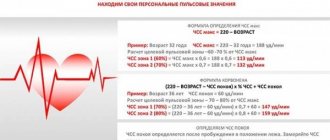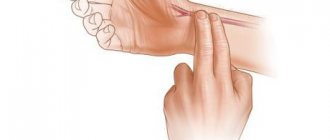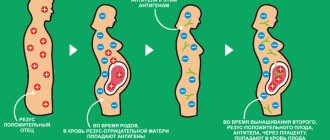What is the normal heart rate during sleep?
Sleep is vital for every person, because during sleep after daytime stress the body relaxes.
But the nervous system, breathing, blood circulation, speech and hearing continue to function, thanks to the tireless work of the cerebral cortex. It is this zone in a person’s head that makes some systems work in a dream, while giving others time to rest. The pulse also continues to beat in sleep, although with a noticeable slowdown.
This happens because some organs are at rest and do not require an increased supply of oxygen; metabolism will slow down, so to speak.
In adults
The normal heart rate during sleep in an adult should not be lower than 8% than when awake. For example, during the day in a calm environment and without physical activity, the heart rate shows from 70 to 80 beats per minute.
Then a normal heart rate during sleep will be considered to be between 60 and 75 beats per minute. The pulse rate before bedtime may gradually slow down, as the brain gives signals to all organs, informing that rest will soon occur.
At night, during sleep, with a decrease in heart rate, a slight drop in body temperature may occur. The average heart rate in men during sleep is considered to be from 60 to 70 beats per minute, and in women, the normal heart rate during sleep can be called a heart rate of 65 to 75 beats per minute.
Remember! These are only approximate indicators of normal heart rate during sleep, which can be applied to most healthy people, but not to all.
Again, these indicators in adults may be different, since the pulse rate of a sleeping person also depends on the following factors:
- emotional condition;
- physical training;
- presence of diseases of the cardiovascular system;
- age.
A sleeping person's heart rate can also change as it progresses through the five different stages of sleep. During the first four phases, the pulse rate gradually slows down, and in the fifth phase, as a rule, it increases. If a person sleeps without dreaming, then his pulse will be measured and calm throughout the night.
Differences in heart rate when awake (in a state of relative rest) or during sleep in physically healthy adults should not be too large. The generally accepted difference, as we mentioned above, between these two physiological states is considered to be 8%.
This means that you can find out the normal heart rate for sleep by calculating the value using the following formula (the letter “P” is pulse):
Sleep P = Wake P * 0.92
or
Sleep P = Wake P * 92%
or
P of sleep = P of wakefulness - 8%.
Since these actions are equivalent from a mathematical point of view, it does not matter which one is chosen to calculate the average heart rate during sleep. The normal heart rate for men and women during sleep, according to any of the above formulas, will be considered (the average value was taken into account):
- P adults under 50 years old, sleep = P adults under 50 years old - 8% = 64.4 (approximately 64 beats/min);
- P adults 50-60 years old, sleep = P adults 50-60 years old - 8% = 68.08 (approximately 68 beats/min);
- P adults 60-80 years old, sleep = P adults 60-80 years old - 8% = 72.68 (approximately 73 bpm);
- P adults, cf. male, sleep = P avg. male - 8% = 69.92 (approximately 70 beats/min);
- P adults wed. female, sleep = P adults, cf. female - 8% = 71.76 (approximately 72 beats/min).
A pulse of 30-35, 40-50 beats per minute during sleep is considered low; if there is a constant deviation from the above norms, it is recommended to undergo an examination.
In children
Children's heart rates are noticeably different during the day and at night. Choose a convenient time to measure your heart rate, count your heart rate before and during sleep. To accurately determine your child's heart rate, it is better to take measurements at the same time for several days in a row, after putting the child to bed.
Pulse readings can be affected to varying degrees by:
- child's age;
- weight;
- presence of diseases;
- body position.
It is worth considering that in order for the indicator to be correct, it is advisable to measure the pulse in children on both hands. The heart rate should be the same on both the right hand and the left. If differences in readings are observed, this indicates that the blood circulation of one of the limbs is impaired, which in turn may be associated with the presence of internal diseases.
The pulse in children during sleep, as in adults, beats much slower than in the waking state, with deviations downward by 8-10%. From a physiological point of view, a slow heart rate during sleep is considered normal. The heart rate rate is calculated using the same formula as for adults.
When measuring your baby's pulse, always take his body temperature into account. An increase in body temperature from normal by 1 degree, in parallel, increases the pulse rate by 10 beats/min.
In children in the first year of life, the normal heart rate during sleep will be about 90-120 beats per minute, and for older children, aged 2 to 10 years, 70-80 beats. Thus, the heart rate of a healthy child can vary within fairly wide limits, which undoubtedly depends on age and health status.
The average heart rate values during sleep for children by age will be as follows:
- from 1 to 3 months - 100-155 beats/min., on average 120 beats/min.;
- from 4 to 12 months - 90-150 beats/min., on average 110 beats/min.;
- 2 years - 82-140 beats/min., on average 105 beats/min.;
- 3 years - 80-120 beats/min., on average 90 beats/min.;
- 4 years - 78-118 beats/min., on average 90 beats/min.;
- 5 years - 75-110 beats/min., on average 85 beats/min.;
- 6 years - 75-90 beats/min., on average 84 beats/min.;
- 7 years - 75-82 beats/min., on average 78 beats/min.;
- from 8 to 9 years - 73-78 beats/min., on average 76 beats/min.;
- from 10 to 11 years - 70-75 beats/min., on average 73 beats/min.;
- from 12 to 18 years - 65-70 beats/min., on average 68 beats/min.
Any fluctuations outside the norm that are observed over a long period of time are a signal for parents to contact a cardiologist and conduct a comprehensive examination.
Why does it become more frequent?
During sleep, when the brain is active, people often see colorful dreams. These can be either good dreams or nightmares. It is because of them that the heart rate increases. There is probably no person who has not at least once woke up in a cold sweat with a rapid heartbeat. It happens that because of nightmares, a person is thrown out of sleep when falling asleep, and at the same time his pulse increases.
Seeing this kind of dream can increase not only your pulse, but also your blood pressure. By waking up and lying down for a few minutes, trying to relax, you can reduce your heart rate to normal.
A high pulse during sleep in an adult indicates that either you had some kind of vivid dream and your brain began to work actively, or you have diseases of the cardiovascular system, and even in sleep the heart does not slow down, but works actively .
Heart rate may also increase at night due to the following reasons:
- dysfunction of the thyroid gland;
- anemia;
- nervous emotional state for a long time;
- poisoning;
- heart failure;
- internal bleeding;
- dehydration.
When a person suffers from colds or infectious diseases, his body temperature rises. This is the body’s protective reaction to an external aggressor – microbes. By increasing body temperature, the body tries to destroy viruses and microbes, and in this condition the pulse will increase during sleep.
A high heart rate at night often leads to insomnia, since it is quite difficult to fall asleep with a strong heartbeat.
This phenomenon can be triggered by regular nervous tension, insufficient rest, conflicts in the family or at work, physical fatigue, abuse of medications or harmful substances.
High rhythm after sleep
Both adults and children often experience a high heart rate in the morning after sleep. But a little time passes - 10-15 minutes, and the pulse rhythm begins to return to its normal norm.
This condition is considered quite common in a healthy person. The body wakes up, and gradually all systems begin to work.
Jumping right out of bed puts a sharp strain on the heart, so doctors recommend lying down for 10 minutes after waking up to normalize your heart rate after sleep.
It is extremely rare that after waking up, a decreased pulse may be observed; to increase it, it is enough to do light morning exercises.
The heart is a muscle like all the others in the body, and it simply needs constant moderate physical activity. Light exercise in the morning will keep the heart muscle toned and normalize its rhythm.
An increased heart rate after sleep indicates that either the person had a restless sleep due to nervous experiences, or it is worth checking their cardiovascular system with a cardiologist. To lower your heart rate, it is recommended to lie quietly for a few minutes and try not to think about the bad and the things of the next day.
How to measure correctly
To measure your heart rate while you sleep, just ask a loved one to count the number of pulsations in your wrist vein while you sleep.
There is also a wonderful assistant for tracking your heart rate while you sleep - a heart rate monitor with a smart alarm clock.
Such a bracelet will give accurate information about your night pulse and will also wake you up in time. All you need to do is set the wake-up interval.
While the hostess or owner is dreaming, the heart rate monitor records posture positions, builds graphs, and reads sleep phases.
Then he chooses the best moment to get up, which is why the person wakes up alert and well-rested. To awaken, it is not music that is used, but soft vibration.
The normal heart rate during sleep is not a fixed indicator; it depends on our state during sleep. But it is necessary to examine the pulse at night in the same way as during the day in order to identify abnormalities and timely diagnose the body. It is naive to think that by measuring the pulse you can immediately understand whether there is a disease or not.
A pulse with one or another indicator can only tell you whether there is a threat to health, or everything is in order.
A regularly high or too low pulse during sleep often indicates that various pathological processes are occurring in the body, and a person should consult a specialist for help in identifying the disease.
Source: https://PulsNorma.ru/puls-vo-vremya-sna
Night pulse is normal - Heart
If the heart rate is below 60 beats per minute, then this may be functional in nature or indicate a number of pathologies. Functional bradycardia is most often observed in athletes and in any person during sleep.
It should be noted that in people who are professionally involved in sports, heart rate can decrease to 40 beats per minute. This is normal and is associated with the peculiarities of the autonomic regulation of heart contractions.
Pathological bradycardia is detected with myocardial infarction, inflammation of the heart muscle, intoxication, as well as against the background of age-related changes in the heart and blood vessels, high intracranial pressure, peptic ulcer, myxedema or hypothyroidism. With organic lesions of the heart, the heart rate can be 50 or less beats per minute.
As a rule, a decrease in heart rate occurs when there are disturbances in the conduction system of the heart, which leads to changes in the passage of electrical impulses through the myocardium. Minor changes in sinus rhythm are not accompanied by complaints.
If in a normal state the pulse is significantly reduced, dizziness, weakness and cold sweat may appear, and due to insufficient blood supply to the brain, loss of consciousness may occur (due to severe hypoxia).
It is also worth mentioning drug-induced bradycardia, which is associated with the use of certain pharmacological agents, as well as its idiopathic form, when a weak pulse is recorded for no apparent reason.
What pulse should an adult have, and what do its changes indicate?
In Chinese ancient medicine, there are up to 70 different types of pulse. It is interesting that here they diagnose the body based specifically on measuring the pulse.
This is a kind of indicator of the health of the entire human body. Indeed, the rhythm of the heart plays a vital role in our lives, and if there are any malfunctions in the functioning of this or another organ, the pulse will definitely give a signal about it.
So what kind of heart rate should an adult have to be able to say that it is normal?
Normal heart rate according to WHO
Interestingly, this indicator is very different in children and adults. Thus, the heart rate of an infant is approximately twice as high as that of an adult. With age, the heart rate decreases, and by the age of 17, a teenager’s heart rate approaches the “adult” mark.
According to WHO, the normal heart rate for an adult ranges from 60 to 80 beats per minute. A slight increase is also allowed - up to 90 strokes.
If the values are higher or lower, you should consult a doctor, as this may indicate any disturbances in the functioning of the heart or other diseases. For example, many athletes have very low heart rates - up to 40 beats, that is, they suffer from bradycardia.
An ordinary person who does not have constant exhausting physical activity should not have this.
Pulse and cardiac abnormalities
In some cases, the pulse rate may not match the heart rate. This condition is typical for people suffering from extrasystole or atrial fibrillation.
These are one of the most common types of arrhythmia. Often, an increase in heart rate is caused by drinking alcohol and large amounts of caffeine, as well as smoking.
If a person at rest experiences an increase in heart rate, then this is one of the signs of the following diseases: heart failure, fever, anemia and some others.
Day and night pulse
By the way, heart rate indicators differ during the day and at night. What should be the heart rate of an adult in a state of sleep? On average, at night this figure drops to 1.4 times.
The lowest heart rate can be recorded at approximately 4 am. This is due to the activity of the vagus nerve, which inhibits the heart at night, and the next morning the pulse is low (32 beats per minute or even lower).
This is why the risk of heart attacks and other cardiovascular complications usually increases in the early morning (4-5 am).
It is very important to note that the normal heart rate of an adult, recorded in both arms, should be the same. Otherwise, the discrepancy may indicate disorders that impede the flow of blood into one of the extremities (arteritis, stenosis of the aorta or peripheral arteries).
Changes in heart rate and their causes
By measuring your heart rate during different activities, you can see that it can vary significantly. What heart rate should an adult have when playing sports? This indicator is individual for everyone.
To determine your maximum heart rate, subtract the number of years you have lived from 200. For example, a person aged 50 years should have a heart rate of no more than 150 beats (in a state of physical activity).
The pulse rate changes depending on age, external factors, and the load on the body.
For example, in an adult under the age of 50, a pulse that ranges from 60 to 80 beats per minute is considered normal. From 50 to 60 years the indicators are already different - 64–84 beats per minute. After the age of 60, 69–89 beats per minute is considered normal.
Predictions and prevention
If the bradycardia is of a physiological form and is moderate in nature, then the prognosis is usually positive.
Negative prognoses of bradycardia include: organic heart damage, thromboembolic complications, and disability of the patient.
The danger of heart palpitations is that it can cause the following complications:
- heart attack;
- stroke;
- cardiac asthma;
- cardiac arrest;
- pulmonary edema;
- impaired blood circulation in the brain;
- heart failure.
To prevent the development of arrhythmia, you must always monitor your health and treat all diseases in a timely manner. You should not take any medications uncontrollably. All factors that can provoke such a disorder in the body should be eliminated as much as possible.
To ensure good heart function, you should give up all bad habits, get rid of excess weight, do not subject your body to excessive physical activity, and try to avoid stressful situations.
Rest is of great importance. A person who gets enough sleep is less susceptible to various heart problems.
You should spend more time outdoors, play sports, and increase your physical activity. You need to pay attention to nutrition, enrich it with fruits, vegetables, dairy products and fish.
Every day a person is exposed to various factors that can cause abnormal heartbeat. But it is worth knowing that at the first signs of a rapid or slow pulse, you should consult a doctor. It will help determine what disease caused it.
dlyaserdca.ru
Source: https://serdse.top/puls-vo-sne-norma/
Pulse in children by age: table of norms from 0 to 18 years - features and what affects the indicators
The heart rate in children is mainly determined by age, well-being, air temperature, and the environment in which the count is performed. The walls of the arteries contract with impulses, which leads to the appearance of beats (pulse). As children grow older, their heart rate (heart rate) decreases .
In the fetus
You can notice fluctuations in the baby’s heart at the beginning of the first trimester; the rhythm is rapid and changes with the development of the fetus. pulse at 6–8 weeks is 110–130 beats, from 8 to 11 it reaches 190, from 11 weeks – 140–160, varies several times a day.
in newborns
- The baby's heartbeat (the first 4 weeks after birth) with anxiety increases to 160–200 beats.
- 120–140 beats is normal.
- Children born prematurely have a higher heart rate than a child born at full term.
in infants
A baby is considered a child from 30 days to 1 year. By the age of one year, the baby’s normal heart rate is 132 beats. Normally, the heart rate in children increases to 162.
in young years
In a child under 7 years of age, the nervous system is at a stage of increased development, which is the reason for the increase in heart rate in children. for a 2-year-old child, the normal heart rate is 124 beats; physical activity or stress leads to a frequency from 94 to 154 beats.
in preschoolers
The age of preschoolers is conventionally divided into three periods:
- junior preschool age - from 3 to 4 years;
- average preschool age - from 4 to 5 years;
- senior preschool age - from 6 to 7 years.
The normal pulse rate for 6-year-old children, as can be seen from the table, is 106 beats.
The pulse of school-age children is 80–120 beats.
In children 9–10 years old, the normal heart rate is considered to be 108 beats per minute.
in teenagers
Pulse rates in adolescents gradually drop to 65–100 beats, and upon reaching puberty they reach 60–90 beats. A teenager's heart rate is normal - 75
pivot table
| Age | Minimum (bpm) | Average value (bpm) | Maximum (bpm) | |
| In newborns | Up to a month | 110 | 140 | 170 |
| In infants | From 1 month to a year | 102 | 132 | 162 |
| In young years | 1–2 years | 94 | 124 | 154 |
| In preschoolers (younger preschool age) | 3–4 | 90 | 110 | 130 |
| For preschoolers (middle and senior preschool age) | 5–6 | 86 | 106 | 126 |
| For schoolchildren | 7–8 | 78 | 98 | 118 |
| 9–10 | 68 | 88 | 108 | |
| 11–12 | 65 | 82 | 100 | |
| In teenagers | 13–15 | 63 | 79 | 95 |
| 16–18 | 60 | 75 | 90 |
Skipping or extra beats in the pulse indicate heart disease.
How to calculate heart rate?
Children's pulse measurements are taken after eating and in a ventilated room. Before starting to count the heartbeat, wait until the child calms down and put him in bed with his arm extended, palm up. In children, the pulse is measured at the radial artery.
Using the tips of 2, 3, 4 fingers, feel the artery and gently press it. Count your heartbeats in 60 seconds. To clearly understand the child’s heart rate, repeated measurements are taken. During deep sleep, children's heart rate is minimal and reaches its maximum value at approximately 10–12 o'clock.
Do not put too much pressure on the carotid artery, as this will lead to dizziness.
What influences the indicators?
Factors influencing heart rate indicators:
Age
The heart rate decreases as the child gets older. When a baby is born, the heart beats approximately 120 times per minute. Children have a heart rate of 100 beats. In people under 65 years of age, the heart rate should be 70–80. People over 65 years old have a heart rate of 60.
Physical activity
During physical exercise, the human body's organs work intensively, which is facilitated by an increase in oxygen consumption. The supply of oxygen to muscle cells forces blood flow and heart rate to increase.
Health status
Children's heartbeat is negatively affected by: negative emotions, digestive problems and feelings of fear. Deviation of a person's weight from the norm leads to a change in heart rate.
Medicines
Drugs that patients use to prevent or treat blood pressure narrow or dilate the blood vessels of the heart, thereby increasing or decreasing the heart rate.
Why does your heart rate change with age?
The human heart, like any muscle, grows (aging) as we grow older and loses the elasticity of the blood vessels of the circulatory system. The total length of human blood capillaries reaches 100,000 km; waste and toxins constantly accumulate in them.
Reasons why heartbeat changes over the years:
- ineffectiveness of the heart muscle;
- decreased elasticity of blood vessels;
- increased sensitivity to adrenaline (the fear hormone).
These factors lead to a decrease in the volume of blood ejected by the heart and a decrease in heart rate.
Symptoms and causes of low readings
Low heart rate (bradycardia) in children can be acquired or congenital. The disease is diagnosed:
- in newborns with a pulse less than 100 beats per minute;
- in children 1–6 years old: 79–80;
- in school age: less than 60 beats.
Symptoms:
- weakness;
- profuse sweating;
- instability
- loss of consciousness;
- loss of appetite;
- the appearance of shortness of breath.
Accurate identification of the cause of the disease guarantees effective treatment.
The causes of low blood pressure may be:
- systematic fasting;
- hypothermia;
- infectious diseases;
- poisoning of various types.
Diseases directly related to the work of the heart (atherosclerosis, hypotension, myocardial infarction, endocarditis) also help reduce the patient’s blood pressure.
If your heart rate is below 50 beats/min, contact your doctor immediately.
Symptoms and causes of high readings
A high heart rate (tachycardia) is considered normal in children under 7 years of age.
An increase in the child's body temperature by 1 degree increases the pulse by 7-12 beats.
Symptoms:
- painful tremors in the chest area;
- numbness of fingertips;
- feeling of fainting;
- blurred vision;
- cold extremities;
- general weakness.
Causes:
- thyroid dysfunction;
- pathology of the upper chamber of the heart;
- lung disease.
Coffee, tobacco, tea, lack of vitamins, nervousness, fear, rich foods also stimulate an increase in heart rate
And also read: what to do with a rapid pulse at low, normal and high blood pressure?
What is the normal heart rate during sleep?
The period of dreams takes up a third of a person's lifespan. During sleep, metabolism and metabolic processes slow down. The body restores strength and accumulates energy. The brain does not stop performing its functions.
It sends impulses that ensure continuous respiratory activity and the functioning of the cardiovascular system. The frequency and intensity of signals sent by the brain normalizes and signals the activity of some organs and systems, allowing others to relax and rest. Normally, the number of heart beats per minute decreases during rest.
The slowdown is due to a decrease in the activity of metabolic processes, a decrease in the need of cells for oxygen.
Pulse during sleep
During sleep, a person's pulse tends to decrease, along with blood pressure, metabolism and temperature - this is a normal phenomenon due to the deep relaxation of the body.
As you go to sleep, your heart rate gradually decreases and, according to research, this process can begin even at the stage of preparing for sleep. The pulse rate during sleep can be influenced by factors such as age, recent stress, and the level of physical condition of the body.
Many experts in the field of cardiovascular activity agree that the pulse during sleep should be lower than usual (while awake by 10%. You need to understand that the pulse value cannot be fixed, it is constantly changing based on the current state.
It can go beyond the average boundaries due to excitement or stress, joy or depression. However, for a healthy body, five minutes is enough to return to its original state.
Pulse before bed
The rhythm of the heartbeat before going to bed gradually slows down, because the brain begins to send signals to all organs that rest is coming.
If the human body is in a calm state and if there are no emotional stimuli or diseases of the cardiovascular system, then a pulse rate of 55-60 beats per minute is quite normal.
It is believed that early in the morning and before bedtime the lowest heart rate.
Normal heart rate in a person during sleep
In a state of sleep, an adult's pulse can vary within certain values, similar to daytime. This is due to the fact that sleep has at least 5 phases and in each of them the heart rate can be different.
From the first to the fourth phase, the body relaxes more and more deeply. This is approximately 70-80% of total sleep. Typically, a person’s pulse slows down already in the first phase and as the rest begins and passes, it becomes even slower.
The fifth phase - the REM sleep phase (it is at this stage that dreams occur) can significantly change the physiological state.
This is probably due to emotional reactions to dreams and at this stage the heart rate increases noticeably and can become higher than normal when awake at rest. Here, too, breathing may increase and other physiological processes, such as sweating, may be triggered.
If sleep proceeds calmly, without dreams, the heart rate may be measured and not change throughout sleep. The normal rhythm should be a pulse rate of 70 beats/minute. This average heart rate rate applies to a healthy person.
More on the topic: Dream and its meaning
Changes in heart rate during sleep
In a healthy person, heart rate tends to decrease during sleep. Scientists say that heart rate directly depends on the depth of sleep and the presence of dreams.
However, it often happens that in a dream the heart begins to beat wildly, thereby increasing the pulse. This can be of different nature. An increase in heart contractions may well be a harbinger of vegetative-vascular dystonia, neurotic disorders or allergic reactions.
Frequent heartbeat indicates a malfunction of the nervous system, cardiovascular diseases, problems with the lungs or thyroid gland.
Tachycardia during sleep entails sleep disturbance, provoking groundless anxiety, and possibly causing headaches and chest pain.
Another reason for an increase in heart rate is unpleasant, nightmares. Perhaps everyone has ever woken up in the middle of the night in a cold sweat and with a racing heart. In this case, you need to reduce your heart rate - drink water, lie down and relax.
Pulse after sleep
In the morning, after a person wakes up, he (adults and children) may experience frequent pulsation.
However, after five to ten minutes it will gradually normalize and return to normal. This condition should not cause alarm; in a healthy subject it is considered normal. The body recovers from sleep and all systems gradually begin to work.
A high heart rate after sleep may indicate an anxious, restless sleep caused by worries or nervous excitement, or have the organs responsible for blood circulation checked by a cardiologist.
A sharp rise to a vertical position puts a rapid load on the heart muscle, so doctors strongly recommend lying down for a while after waking up to normalize cardiac activity. It is quite rare to experience a weak, low pulse upon waking up.
To bring it back to normal and increase it, just do morning exercises or light exercises. The heart is a powerful muscular organ; just like other muscles, it needs regular, reasonable physical activity that will keep it in good shape, normalize rhythm, blood pressure and strengthen the cardiovascular system as a whole.
More on the topic: Hands go numb during sleep
How to measure pulsation correctly
To ensure that your heart rate readings during sleep are as accurate as possible, you need to follow simple rules:
- take measurements during deep sleep,
- make sure the person is relaxed
- make sure he doesn't have disturbing dreams.
Measurements are carried out manually or using instruments (tonometer, bracelet).











